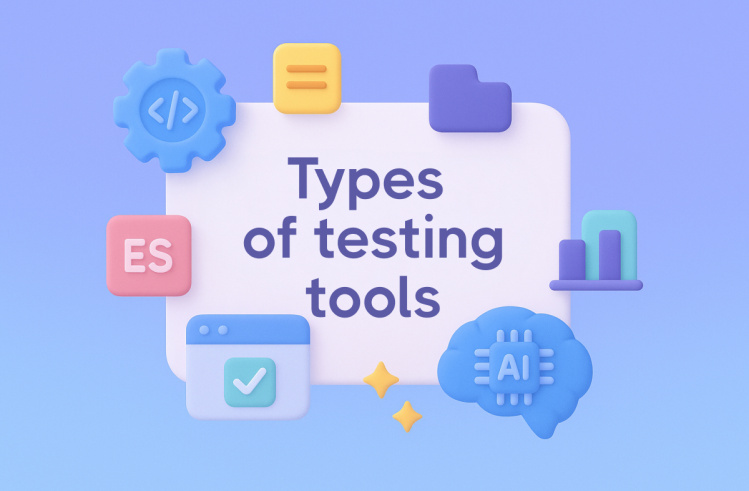Unit tests catch bugs before they reach production. But only if your tools make testing easy. Yet, the developers skip unit testing when frameworks feel clunky. Test suites become outdated. Code quality suffers.
The pain points are real:
- Writing tests takes longer than writing code
- Test maintenance becomes a burden
- No visibility into test coverage across projects
- Disconnected from CI/CD workflows
Modern unit testing tools integrate with your development cycle, generate tests automatically, and show coverage in real time. They don’t just execute tests, they help you write, manage, and optimize them.
What Are Unit Testing Tools?
Unit testing tools are frameworks and platforms that help developers test individual code units, functions, methods, classes, in isolation. They verify that each part of the code works correctly before those parts combine into larger systems. Their purpose in software development is straightforward:
- Catch bugs at the source before they compound into expensive production issues.
- Enable confident refactoring knowing tests will catch breaking changes.
- Document expected behavior through executable specifications.
- Support continuous integration by providing fast, automated validation.
Key characteristics separate good unit testing tools from everything else:
- Fast execution — thousands of tests in seconds, not minutes.
- Isolated test environment — no dependencies on databases, APIs, or external services.
- Clear pass/fail results — no ambiguity about what broke.
- Easy assertion syntax — readable tests that express intent clearly.
In agile development, unit testing tools play a critical role: They enable Test-Driven Development (TDD), where tests guide code design. They support continuous testing in CI/CD pipelines, catching regressions before merge. They provide immediate feedback to developers during coding. They reduce debugging time in later stages by catching issues early.
The evolution has been significant. We’ve moved from manual testing scripts to sophisticated frameworks with parallel execution, mocking capabilities, and intelligent reporting. Now we’re entering the AI era, tools that generate tests automatically and optimize execution based on code changes.
Top 5 Unit Testing Tools for 2025
1. Testomat.io — AI-Powered Unit Test Management & Orchestration
While most unit testing frameworks stop at execution, Testomat.io manages, orchestrates, and optimizes your entire unit testing workflow with AI.
Testomat.io is a complete test management platform that works with all major unit testing frameworks. You keep using Jest, JUnit, pytest, or NUnit for execution. Testomat.io adds the intelligence layer on top: AI test generation, centralized visibility, intelligent orchestration, and team collaboration.
- Multi-Framework Support. Works with Jest, Mocha, JUnit, pytest, NUnit, PHPUnit, and more. Import existing unit tests automatically. Sync test suites with your codebase. No need to rewrite tests or change frameworks. Your frontend team uses Jest, backend uses JUnit, data team uses pytest — Testomat.io unifies them all.
- AI-Powered Test Generation. Generate unit tests from function signatures. Create test cases from GitHub issues or Jira stories. AI suggests edge cases and boundary conditions you might miss. Reduce manual test writing by 60-70%. The AI analyzes your code structure, understands patterns, and produces test-ready scenarios.
- Test Coverage Analytics. Real-time coverage metrics across all projects. Identify untested code paths immediately. Track coverage trends over sprints. Visual coverage reports for stakeholders. No more hunting through terminal output or Jenkins logs to find coverage gaps.
- CI/CD Integration. Native integration with GitHub Actions, GitLab CI, Jenkins. Parallel test execution across runners. Automatic retry for flaky unit tests. Real-time test results in pull requests. Tests run faster, results appear instantly, developers get feedback without leaving their workflow.
- Team Collaboration. Developers, QA engineers, and team leads in one workspace. Assign test creation and maintenance tasks. Review test quality before merging. Link unit tests to requirements and user stories. Testing becomes visible to the entire team, not just developers.
- Flaky Test Detection. Identify unreliable unit tests automatically. Track pass/fail patterns over time. Prioritize stabilization efforts based on impact. Quarantine problematic tests until they’re fixed. Stop wasting CI/CD time on tests that fail randomly.
- Test Data Management. Organize test fixtures and mock data. Share reusable test utilities across teams. Version control for test data. Parameterized test support. Clean separation between test logic and test data.
Best for: Development teams wanting AI-assisted test management, centralized visibility, and intelligent orchestration across all unit testing frameworks.
2. Jest — JavaScript Unit Testing Framework
Jest is Facebook’s zero-config JavaScript testing framework. It’s become the standard for React, Node.js, and TypeScript projects. If you write JavaScript, you’ve probably encountered Jest.
Key Features:
- Zero configuration — works out of the box for most JavaScript projects
- Snapshot testing — captures component output and detects UI changes
- Built-in mocking — mock functions, modules, and timers without third-party libraries
- Code coverage — generates coverage reports automatically with –coverage flag
- Parallel execution — runs tests concurrently for speed
- Watch mode — reruns affected tests on file changes during development
Fast test execution with intelligent parallelization that uses all CPU cores. Excellent error messages that pinpoint failures with stack traces and diffs. Large ecosystem and community support with thousands of packages. Works seamlessly with React, Vue, Angular. TypeScript support built in.
Limitations: JavaScript/TypeScript only, not for other programming languages. Snapshot tests can become brittle without careful maintenance. Large test suites may have memory issues with thousands of tests. Requires configuration for complex build setups like monorepos.
3. JUnit — Java Unit Testing Standard
JUnit has been the Java testing standard for over 20 years. JUnit 5, released in 2017, modernized the framework for contemporary Java development with lambda support and modular architecture.
Key Features:
- Annotations-based —
@Test, @BeforeEach, @AfterEachfor clear test structure - Assertions library — rich set of assertion methods for validation
- Parameterized tests — run same test with different inputs using
@ParameterizedTest - Test lifecycle — precise control over setup and teardown
- Extensions model — customize behavior through plugins
- IDE integration — native support in IntelliJ, Eclipse, VS Code
Industry standard with massive adoption across enterprise Java shops. Excellent documentation and learning resources. Works with Maven, Gradle build tools seamlessly. b integration with Spring Framework for testing Spring Boot applications. Mature ecosystem of extensions for special testing needs.
Limitations: Java-only framework. Verbose syntax compared to modern frameworks like pytest. Requires understanding of annotations. Test setup can become complex in large projects with many dependencies.
4. pytest — Python Testing Framework
pytest is Python’s most popular testing framework. It’s known for simple syntax, powerful features, and an extensive plugin ecosystem with 800+ plugins for specialized testing needs.
Key Features:
- Simple test syntax — functions starting with
test_become tests automatically - Fixtures — reusable setup code with dependency injection
- Parametrize decorator — run tests with multiple data sets using
@pytest.mark.parametrize - Rich assertion introspection — detailed failure messages without boilerplate
- Plugin architecture — 800+ plugins for extended functionality
- pytest-cov — built-in code coverage integration
Minimal boilerplate means you write tests faster. Works with existing unittest tests without migration. Scales from simple scripts to large applications. Excellent for data science and ML testing with numpy/pandas integration. Active development and community.
Limitations: Python-only framework. Complex fixtures can become hard to understand and debug. Less familiar to developers from other languages. Plugin compatibility issues occasionally arise with version mismatches.
5. NUnit — .NET Unit Testing Framework
NUnit is the leading unit testing framework for .NET and C#. It’s been the standard for .NET developers for nearly two decades, evolving through multiple .NET versions.
Key Features:
- Attribute-based —
[Test], [SetUp], [TearDown]annotations - Rich assertions — extensive library of assertion methods
- Parameterized tests —
[TestCase]and[TestCaseSource]attributes - Parallel execution — run tests concurrently across cores
- Multiple assertion — continue test after assertion failures with
Assert.Multiple - Visual Studio integration — native test explorer support
Mature framework with proven reliability. Excellent performance for large test suites. Works across .NET Framework and .NET Core/.NET 5+. b community and documentation. Compatible with CI/CD pipelines like Azure DevOps.
Limitations: .NET ecosystem only. Less intuitive than newer frameworks. Requires understanding of attributes. Documentation sometimes lags behind releases.
How to Choose the Right Unit Testing Tool
Factor 1: Programming Language
Match your tech stack. Jest for JavaScript/TypeScript. JUnit for Java. pytest for Python. NUnit for .NET. Multi-language projects benefit from Testomat.io to manage tests across different frameworks in one platform.
Factor 2: Team Experience
Beginners need frameworks with gentle learning curves — Jest and pytest excel here. Enterprise teams prefer mature tools with extensive documentation like JUnit and NUnit. Mixed skill levels benefit from Testomat.io’s unified interface regardless of underlying framework.
Factor 3: Project Size
Small projects work fine with any framework — choose based on language. Large codebases need speed, parallelization, and coverage tracking. Microservices architectures get messy fast — Testomat.io aggregates tests across 50+ services.
Factor 4: CI/CD Requirements
All frameworks integrate with CI/CD pipelines. Consider ease of configuration and reporting quality. Testomat.io provides centralized CI/CD test orchestration with retry logic and parallel execution.
Factor 5: Test Management Needs
Framework alone is good for execution but offers limited visibility. Framework plus test management (Testomat.io) adds coverage analytics, AI generation, and team collaboration.
Factor 6: AI and Automation
Traditional frameworks require manual test writing. Testomat.io generates tests automatically from code and requirements. Reduces test creation time by 60-70%.
Decision Framework:
- JavaScript/TypeScript → Jest + Testomat.io
- Java/Spring → JUnit + Testomat.io
- Python → pytest + Testomat.io
- .NET/C# → NUnit + Testomat.io
- Multi-language → Testomat.io for unified management
Key insight: Your unit testing framework handles execution. Testomat.io handles management, orchestration, visibility, and AI-powered optimization across all frameworks.
Unit Testing Best Practices
Test-Driven Development catches bugs before they exist. Forces better code design by making you think about interfaces first. Tests document expected behavior as executable specifications.
✅Keep Tests Fast
Unit tests should execute in milliseconds, not seconds. Mock external dependencies like databases, APIs, file systems. Run slow tests separately in CI/CD integration stages.
✅Test One Thing Per Test
Each test validates single behavior. Makes failures easy to diagnose — you know exactly what broke. Improves test maintainability by reducing coupling.
✅Use Descriptive Names
Test name should explain what’s being tested and expected outcome. Example: test_user_login_with_invalid_password_returns_error(). Avoid generic names liketest1() or testFunction().
✅Maintain High Coverage
Aim for 80%+ code coverage on critical paths. Don’t chase 100% — focus on important code that affects users. Use Testomat.io to track coverage across projects and identify gaps.
✅Avoid Test Interdependencies
Tests should run in any order without affecting each other. Each test sets up its own data. Clean up after each test to prevent state leakage.
✅Mock External Dependencies
Don’t hit real databases or APIs in unit tests. Use mocks, stubs, or test doubles. Keeps tests fast, reliable, and independent of external systems.
✅Review and Refactor Tests
Tests are code — they need maintenance. Remove obsolete tests that no longer match current functionality. Refactor duplicated test code into fixtures. Testomat.io identifies unused or flaky tests automatically.
Why Testomat.io Enhances Unit Testing
Unit testing frameworks handle execution. Testomat.io handles everything else.
Unified Management Across Frameworks
Your team uses Jest for frontend, JUnit for backend, pytest for data pipeline. Testomat.io aggregates all tests in one dashboard. You see complete coverage without switching tools. No more context switching between Jenkins, GitHub Actions, and local test runs.
AI-Powered Test Generation
AI analyzes your code and generates unit tests automatically. It suggests edge cases you might miss — boundary conditions, null handling, error states. Reduces manual test writing significantly while improving coverage quality.
Real-Time Coverage Visibility
See which code paths lack tests immediately. Track coverage trends over sprints to ensure quality improves. Identify risky areas before they cause production bugs. Product managers get visibility without learning Git or CI/CD tools.
Intelligent CI/CD Orchestration
Run tests in parallel across multiple runners for faster builds. Retry flaky tests automatically without manual intervention. Get instant notifications when tests fail. Results sync to pull requests so developers see failures immediately.
Team Collaboration
Developers write tests. QA reviews quality. Managers track progress. Everyone works in one workspace. No more scattered test documentation in wikis, spreadsheets, or Notion pages.
Flaky Test Detection
Identify unreliable tests through pattern analysis. Prioritize fixes based on impact to build stability. Quarantine problematic tests until stabilized. Stop wasting developer time investigating false failures.
Enterprise Scale
Manage 100,000+ unit tests across dozens of projects. Track test execution metrics over months. Support distributed teams across time zones. Handle complex microservices architectures without losing visibility.
Next Steps
Unit testing keeps your codebase healthy. But tests only work if your team actually writes and maintains them.
Modern unit testing tools remove friction. Jest, JUnit, pytest, and NUnit provide excellent execution frameworks for their respective languages. They handle the technical work of running tests efficiently.
Testomat.io adds the layer most teams miss: management, visibility, and intelligence. It turns scattered test suites into organized, AI-enhanced testing workflows.
Your team gets:
- Centralized dashboard for all unit tests
- AI-generated tests from code and requirements
- Real-time coverage metrics and trend analysis
- Seamless CI/CD integration across frameworks
- Collaboration tools for distributed teams
- Flaky test detection and optimization
Try Testomat.io free and transform your unit testing workflow. Import your existing Jest, JUnit, pytest, or NUnit tests in minutes. See how AI-powered test management accelerates development without replacing your framework.
Start with 2 users and 2 projects completely free. Scale as your team grows.
Start your free trial or schedule a demo to see Testomat.io’s unit test management in action.
Frequently asked questions
What is unit testing in software engineering?

Unit testing validates individual units of source code: functions, methods, classes, in isolation from other parts of the code. The testing process uses a test framework and test runner to execute test cases against application code. Developers write test scripts with mock objects to simulate dependencies, ensuring code reliability without hitting databases or APIs. This software testing approach catches bugs early in the development process across various platforms and development environments.
How does unit testing differ from integration testing?

Unit testing examines individual components separately, while integration testing validates how parts work together. Unit test frameworks focus on single units of code with mock objects replacing real dependencies. Integration testing checks actual connections between modules, databases, and external services. Both types of testing serve different purposes in quality assurance—unit tests ensure code reliability of individual units, integration tests verify system behavior during execution of test cases across connected components.
What makes a good unit test framework?

The right tool offers fast execution of tests, seamless integration with development environments, and code coverage analysis. Modern software testing tools support asynchronous testing for web applications, provide clear test outcomes, and handle various formats. Key features include test case management, support for mock objects, and test automation capabilities. Java developers need frameworks for java applications, while web testing requires tools for different tech stacks across various platforms with advanced features for regression testing.
How does AI improve the testing process?

AI analyzes source code to generate test cases automatically, reducing time spent writing test cases manually. It identifies untested parts of the code, suggests edge cases, and detects patterns in test outcomes. AI-powered test case management tools optimize execution of test cases, detect flaky tests, and improve code coverage analysis. This transforms test automation from manual work into intelligent software quality assurance, helping teams maintain software quality while shipping new features faster across all types of testing.








